I once provided an answer to SO: Qt - How to create Image that scale with window, and keeps aspect ratio?. The actual intention was to scale an image in a QLabel with original aspect ratio to consume maximum available size.
However, I got the feedback that the suggested solution would not work properly when my Label would be used in a QGridLayout. (This sounds very similar to the issue of the OP.) Hence, I modified the sample to reproduce the issue and fiddled a little bit around with. For me, it seems that resize events of the main window are processed in the QGridLayout but affect layouted image label only partially. (Shrinking is applied but growing not.) Fortunately, I found a very simple work-around: Setting a non-empty frame to the QLabel solved the problem. I had a look into the source code on woboq.org. I hoped to get a hint what the changed frame style would activate (to apply this as fix for my resize issue). Finally, I was not patient enough and put it aside.
Beside of this QLabel in a QGridLayout resize issue, changing the visibility of widgets should cause a proper re-layout. I would prefer show/hide (instead of delete and re-new) as this is surely easier to implement, more efficient, and less error-prone.
I took the old sample code and added a tool button which can be used to toggle the visibilty of some of the layouted widgets:
// Qt header:
#include <QtWidgets>
class LabelImage: public QLabel {
private:
QPixmap _qPixmap, _qPixmapScaled;
public:
void setPixmap(const QPixmap &qPixmap) { setPixmap(qPixmap, size()); }
protected:
virtual void resizeEvent(QResizeEvent *pQEvent);
private:
void setPixmap(const QPixmap &qPixmap, const QSize &size);
};
void LabelImage::resizeEvent(QResizeEvent *pQEvent)
{
QLabel::resizeEvent(pQEvent);
setPixmap(_qPixmap, pQEvent->size());
}
void LabelImage::setPixmap(const QPixmap &qPixmap, const QSize &size)
{
_qPixmap = qPixmap;
_qPixmapScaled = _qPixmap.scaled(size, Qt::KeepAspectRatio);
QLabel::setPixmap(_qPixmapScaled);
}
int main(int argc, char **argv)
{
qDebug() << "Qt Version:" << QT_VERSION_STR;
// main application
QApplication app(argc, argv);
// setup GUI
QMainWindow qWin;
QToolBar qToolbar;
QAction qCmdTgl(QString::fromUtf8("Decoration"));
qCmdTgl.setCheckable(true);
qCmdTgl.setChecked(true);
qToolbar.addAction(&qCmdTgl);
qWin.addToolBar(&qToolbar);
QGroupBox qBox;
QGridLayout qGrid;
// a macro for the keyboard lazy:
#define Q_LBL_WITH_POS(ROW, COL) \
QLabel qLbl##ROW##COL(QString::fromLatin1(#ROW", "#COL)); \
/*qLbl##ROW##COL.setFrameStyle(QLabel::Raised | QLabel::Box);*/ \
qGrid.addWidget(&qLbl##ROW##COL, ROW, COL, Qt::AlignCenter)
Q_LBL_WITH_POS(0, 0);
Q_LBL_WITH_POS(0, 1);
Q_LBL_WITH_POS(0, 2);
Q_LBL_WITH_POS(1, 0);
LabelImage qLblImg;
qLblImg.setFrameStyle(QLabel::Raised | QLabel::Box);
qLblImg.setAlignment(Qt::AlignCenter);
//qLblImg.setMinimumSize(QSize(1, 1)); // seems to be not necessary
qLblImg.setSizePolicy(
QSizePolicy(QSizePolicy::Ignored, QSizePolicy::Ignored));
QPixmap qPM;
if (qPM.load("cats.jpg")) qLblImg.setPixmap(qPM);
else {
qLblImg.setText(
QString::fromLatin1("Sorry. Cannot find file 'cats.jpg'."));
}
qGrid.addWidget(&qLblImg, 1, 1, Qt::AlignCenter);
qGrid.setRowStretch(1, 1); // tell QGridLayout to stretch this cell...
qGrid.setColumnStretch(1, 1); // ...prior to other cells (w/ stretch 0)
Q_LBL_WITH_POS(1, 2);
Q_LBL_WITH_POS(2, 0);
Q_LBL_WITH_POS(2, 1);
Q_LBL_WITH_POS(2, 2);
qBox.setLayout(&qGrid);
qWin.setCentralWidget(&qBox);
qWin.show();
// install signal handlers
QObject::connect(&qCmdTgl, &QAction::triggered,
[&](bool on) {
qLbl00.setVisible(on); qLbl01.setVisible(on); qLbl02.setVisible(on);
qLbl10.setVisible(on); qLbl12.setVisible(on);
qLbl20.setVisible(on); qLbl21.setVisible(on); qLbl22.setVisible(on);
});
// run application
return app.exec();
}
I compiled and tested in VS2013 on Windows 10:

After toggling the Decoration tool button:

Note:
Out of curiosity, I commented the line which changes the frame style
qLblImg.setFrameStyle(QLabel::Raised | QLabel::Box);
and again, resizing of image didn't work properly anymore.



